Exploring the Influence and Impact Factors of Park Green Spaces on the Urban Functional Spatial Agglomeration: A Case Study of Hangzhou
Abstract
1. Introduction
2. Materials and Methods
2.1. Research Area
2.2. Research Methods and Data
2.2.1. Research Methods
- Urban functional spatial profiling. (1) Kernel Density Analysis: This method calculates the density of elements within their surrounding neighborhoods, allowing the spatial distribution and clustering of different elements to be assessed through kernel density analysis [20]. In this study, ArcGIS 10.8 was used with a standard spatial unit of 100 m × 100 m (the same for subsequent references). After comparing the 3000–3500 m bandwidth proposed in previous studies on urban area identification [21] with the default bandwidth in ArcGIS, the default bandwidth was selected for analysis. Using the kernel density calculation of the urban functional space characterization indicators, a single urban functional space profile for Hangzhou was created. (2) Entropy Weight Method: The entropy weight method is an objective weighting approach based on information entropy [22]. In this study, entropy weights were calculated for each urban functional space, and ArcGIS was then used to produce a comprehensive spatial profile of Hangzhou’s urban functional spaces.
- Determining the relationship between park green spaces and urban functional spaces. (1) Bivariate Ripley’s K Function: This function identifies whether features exhibit statistically significant clustering or dispersion within a specific distance range. The bivariate Ripley’s K function allows for the determination of spatial relationships between two sets of features [23,24]. In this study, the Kcross function from the spatstat package in R 4.0.3 was used to compute Ripley’s K function, assessing the spatial relationship between park green spaces and each urban functional space. The distance range for the function calculation was set to 4000 m, referring to the settings in previous studies [24]. (2) Bivariate Global Spatial Autocorrelation Function (Bivariate Moran’s I): This function explores and reveals spatial clustering patterns and characteristics between two variables within a region [25]. In this study, GeoDa 1.16.0.16 was used to perform bivariate global spatial autocorrelation analysis. The relationship between park green spaces and comprehensive urban functional spaces was determined using the Bivariate Moran’s I index value and a Moran scatter plot.
- Measuring the impact efficiency of park green spaces on urban functional space agglomeration. Three indicators are established to measure the effectiveness of park green spaces on the agglomeration of urban functional spaces. (1) Impact Range (): This refers to the area within which park green spaces affect the agglomeration of surrounding urban functional spaces, reflecting the quantity-driven capacity of park green spaces to promote agglomeration. In this study, a spatial profile analysis method is used to determine the impact range of green spaces on urban functional space agglomeration. This method has been applied in studies on urban land price spatial characteristics, spatial structure, and so on [26,27]. Based on the comprehensive spatial profile of urban functional spaces, data profile lines are drawn in eight directions from the center of each park green space. Turning points, where urban functional space growth either shifts, stalls, or declines, are identified and connected to outline the impact range of the park green space, which is then used to calculate the R-value. (2) Impact Intensity (): Due to potential differences in the types and quantities of functional spaces within the impact range, which might result in identical -values, the indicator is introduced to represent the variability of urban functional space within . The calculation formula for is
- 4.
- Exploring the factors influencing park green space agglomeration in urban functional spaces. Geographical Detector (GeoDetector) is a set of statistical methods used to analyze spatial differentiation of geographical phenomena and uncover underlying driving forces [28]. It includes four sub-detectors: a risk detector, factor detector, ecological detector, and interaction detector. In this study, the factor detector and interaction detector sub-tools in R are used to identify external factors (urban spatial functions) and intrinsic characteristics of park green spaces that influence their ability to attract urban functional spaces, as well as the extent of this influence. The data were divided into five categories using the natural breaks method. In the analysis, the total influence indicator of park green spaces () is used as the dependent variable, while external factors and intrinsic characteristics of the green spaces serve as independent variables. This setup allows for the assessment of the factors that most significantly affect the clustering of urban functional spaces around park green spaces, and quantifies their respective influence.
2.2.2. Data Support
3. Results
3.1. The Relationship Between Park Green Spaces and Urban Functional Spaces
3.1.1. The Evolution Characteristics of the Distribution of Park Green Spaces and Urban Functional Spaces
3.1.2. The Agglomeration Characteristics of Park Green Spaces and Urban Functional Spaces
3.2. The Impact Efficiency and Influencing Factors of Park Green Spaces on the Agglomeration of Urban Functional Spaces
3.2.1. Impact Efficiency
3.2.2. Impact Factor
4. Discussion
5. Conclusions
Author Contributions
Funding
Institutional Review Board Statement
Informed Consent Statement
Data Availability Statement
Conflicts of Interest
Abbreviations
| POD | Park-Oriented Development |
| ECD | Ecological, cultural district |
| POI | Point of Interest |
| SHDI | Shannon’s Diversity Index |
| LSI | Landscape Shape Index |
| GDP | Gross Domestic Product |
References
- Mu, B.; Liu, C.; Mu, T.; Xu, X.; Tian, G.; Zhang, Y.; Kim, G. Spatiotemporal fluctuations in urban park spatial vitality determined by on-site observation and behavior mapping: A case study of three parks in Zhengzhou City, China. Urban For. Urban Green. 2021, 64, 127246. [Google Scholar] [CrossRef]
- Xie, X.; Gong, X.; Pan, S. Research on the construction path of the megacity from the perspective of Nudge Theory: Empirical evidence of the “Park City” construction in Chengdu Tianfu New Area. Chin. J. Popul. Resour. Environ. 2023, 21, 163–171. [Google Scholar] [CrossRef]
- Kabisch, N.; Qureshi, S.; Haase, D. Human–environment interactions in urban green spaces—A systematic review of contemporary issues and prospects for future research. Environ. Impact Assess. Rev. 2015, 50, 25–34. [Google Scholar] [CrossRef]
- Zhou, X.; Masud, P.R. Social benefits of urban green space: A conceptual framework of valuation and accessibility measurements. Manag. Environ. Qual. Int. J. 2012, 23, 173–189. [Google Scholar] [CrossRef]
- Wang, Z.; Cheng, H.; Li, Z.; Wang, G. Is greener always healthier? Examining the nonlinear relationships between urban green spaces and mental health in Wuhan, China. Urban For. Urban Green. 2024, 101, 128543. [Google Scholar] [CrossRef]
- Li, F.; Yao, N.; Liu, D.; Liu, W.; Sun, Y.; Cheng, W.; Li, X.; Wang, X.; Zhao, Y. Explore the recreational service of large urban parks and its influential factors in city clusters–Experiments from 11 cities in the Beijing-Tianjin-Hebei region. J. Clean. Prod. 2021, 314, 128261. [Google Scholar] [CrossRef]
- Zhao, J.; Zhu, X. City Park System and City Space Development: The History of Park System Development of Mid-nineteenth Century in Europe and America. Chin. Landsc. Archit. 2014, 9, 13–17. [Google Scholar]
- Zheng, X. Research on the Development Characteristics and Construction Strategies of Urban Parks as Green Complex. Urban Dev. Stud. 2013, 6, 25–29. [Google Scholar]
- Zeng, F.; Wu, C. Spatial Structural Construction Strategy of Park Complex: A Case Study of Singapore. J. Chin. Urban For. 2019, 3, 40–44. [Google Scholar]
- Zang, T.; Zheng, S.; Zhang, L. Study on Spatial Layout Strategy of Shanghai Expo Cultural Park Complex. Shanghai Urban Plan. Rev. 2020, 5, 52–56+62. [Google Scholar]
- Wang, Z.; Wu, Y.; Jing, Z.Y. Park Integrating City and Scenes Constructing City: New Thoughts on the Construction Model of “Park City”. Chin. Landsc. Archit. 2021, 37, 7–11. [Google Scholar]
- Liu, B. Methodology of park city research and construction. Chin. Landsc. Archit. 2018, 34, 10–15. [Google Scholar]
- Lynch, A.J. The role and potential of residential open space in a suburban green space network. Urban For. Urban Green. 2020, 58, 126971. [Google Scholar] [CrossRef]
- Zhang, C.; Li, W.; Huang, W.; Wu, H.; Skitmore, M.; Xia, B.; Wang, W. Comprehensive evaluation in urban green transportation development: Evidence from 30 cities in China. Res. Transp. Bus. Manag. 2024, 57, 101231. [Google Scholar] [CrossRef]
- Zhang, Y.; Sun, S. The Influence of Urban Parks on the Agglomeration of Cultural Consumption Space: A Case Study of Chengdu. Chin. Landsc. Archit. 2023, 39, 83. [Google Scholar]
- Shao, D.; Zhou, Y.; Wu, D. Evolution Characteristics of the Correlation and Coupling between Urban Park Green Space and Social Space—A Case Study of Suzhou. Chin. Landsc. Archit. 2023, 39, 47. [Google Scholar]
- Zhao, X.; Ju, C. Coupling coordination relationship between park green spaces and urban functional spaces and its influencing factors: A case of Urumqi City. Arid Land Geogr. 2024, 47, 898–908. [Google Scholar]
- Batty, M. Empty buildings, shrinking cities and ghost towns. Environ. Plan. B Plan. Des. 2016, 43, 3–6. [Google Scholar] [CrossRef]
- Yin, G.; Liu, Y.; Chen, Y. “Ghost city” or habitable city? The production and transformation of space in China’s new towns. Cities 2024, 145, 104678. [Google Scholar] [CrossRef]
- Zhao, X.; Xia, N.; Li, M. Dynamic monitoring of urban renewal based on multi-source remote sensing and POI data: A case study of Shenzhen from 2012 to 2020. Int. J. Appl. Earth Obs. Geoinf. 2023, 125, 103586. [Google Scholar] [CrossRef]
- Xu, Z.N.; Gao, X.L. A novel method for identifying the boundary of urban built-up areas with POI data. Acta Geogr. Sin. 2016, 71, 928–939. [Google Scholar]
- Li, Z.; Luo, Z.; Wang, Y.; Fan, G.; Zhang, J. Suitability evaluation system for the shallow geothermal energy implementation in region by Entropy Weight Method and TOPSIS method. Renew. Energy 2022, 184, 564–576. [Google Scholar] [CrossRef]
- Batista, A.P.; Scolforo, H.F.; de Mello, J.M.; Guedes, M.C.; Terra, M.C.; Scalon, J.D.; Gomide, L.R.; Scolforo, P.G.; Cook, R.L. Spatial association of fruit yield of Bertholletia excelsa Bonpl. trees in eastern Amazon. For. Ecol. Manag. 2019, 441, 99–105. [Google Scholar] [CrossRef]
- Wu, X.; Shao, D.; Wu, D. Spatiotemporal correlation characteristics between park green space and urban functional space in Nanjing: Based on Ripley’s K function and POI data. Chin. Landsc. Archit. 2023, 39, 92–97. [Google Scholar]
- Lei, C.; Wang, Q.; Wang, Y.; Han, L.; Yuan, J.; Yang, L.; Xu, Y. Spatially non-stationary relationships between urbanization and the characteristics and storage-regulation capacities of river systems in the Tai Lake Plain, China. Sci. Total Environ. 2022, 824, 153684. [Google Scholar] [CrossRef]
- Cesario, E.; Paolo, L.; Andrea, V. A scalable multi-density clustering approach to detect city hotspots in a smart city. Future Gener. Comput. Syst. 2024, 157, 226–236. [Google Scholar] [CrossRef]
- Yin, Z.; Li, W.; Li, C.; Zheng, Y. The relationship between accessibility and land prices: A focus on accessibility to transit in the 15-min city. Travel Behav. Soc. 2025, 38, 100914. [Google Scholar] [CrossRef]
- Wang, J.; Xu, C. Geodetector: Principle and prospective. Acta Geogr. Sin. 2017, 72, 116–134. [Google Scholar]
- Zhang, Z.; Liu, J.; Wang, C.; Zhao, Y.; Zhao, X.; Li, P.; Sha, D. A spatial projection pursuit model for identifying comprehensive urban vitality on blocks using multisource geospatial data. Sustain. Cities Soc. 2024, 100, 104998. [Google Scholar] [CrossRef]
- Deng, P.; Huang, Q.; Liu, F.; Wang, Z.; Liu, M. The research on identification and spatial pattern of urban mixed land-use: A case study of Chengdu. Ecol. Indic. 2023, 154, 110891. [Google Scholar] [CrossRef]
- Jiang, J.; Zhang, J.; Dai, F. Urban functional zones recognition and green space evaluation of Shanghai based on POI data. Chin. Landsc. Archit. 2019, 35, 113–118. [Google Scholar]
- Peng, S.; Chen, S.; Xu, Q.; Niu, J. Spatial characteristics of land use based on POI and urban rail transit passenger flow. Acta Geogr. Sin. 2021, 76, 459–470. [Google Scholar]
- GB 50137-2011; Code for Classification of Urban Land Use and Planning Standards of Development Land. Ministry of Housing and Urban-Rural Development of the People’s Republic of China: Beijing, China, 2010.
- O’Driscoll, C.; Crowley, F.; Doran, J.; McCarthy, N. Land-use mixing in Irish cities: Implications for sustainable development. Land Use Policy 2023, 128, 106615. [Google Scholar] [CrossRef]
- Wang, X.; Ye, R. Research on Urban Functional Mixing Degree in the Central Area of Nanjing based on POI Data. Chin. Overseas Archit. 2024, 3, 77–83. [Google Scholar]
- Verma, A.; Sonam, A. Evaluating the natural cooling potential of waterbodies in dense urban landscape: A case study of Bengaluru, India. Urban Clim. 2024, 58, 102200. [Google Scholar] [CrossRef]
- Lu, J.; Jean-Michel, G. Landscape ecology, land-use structure, and population density: Case study of the Columbus Metropolitan Area. Landsc. Urban Plan. 2012, 105, 74–85. [Google Scholar] [CrossRef]
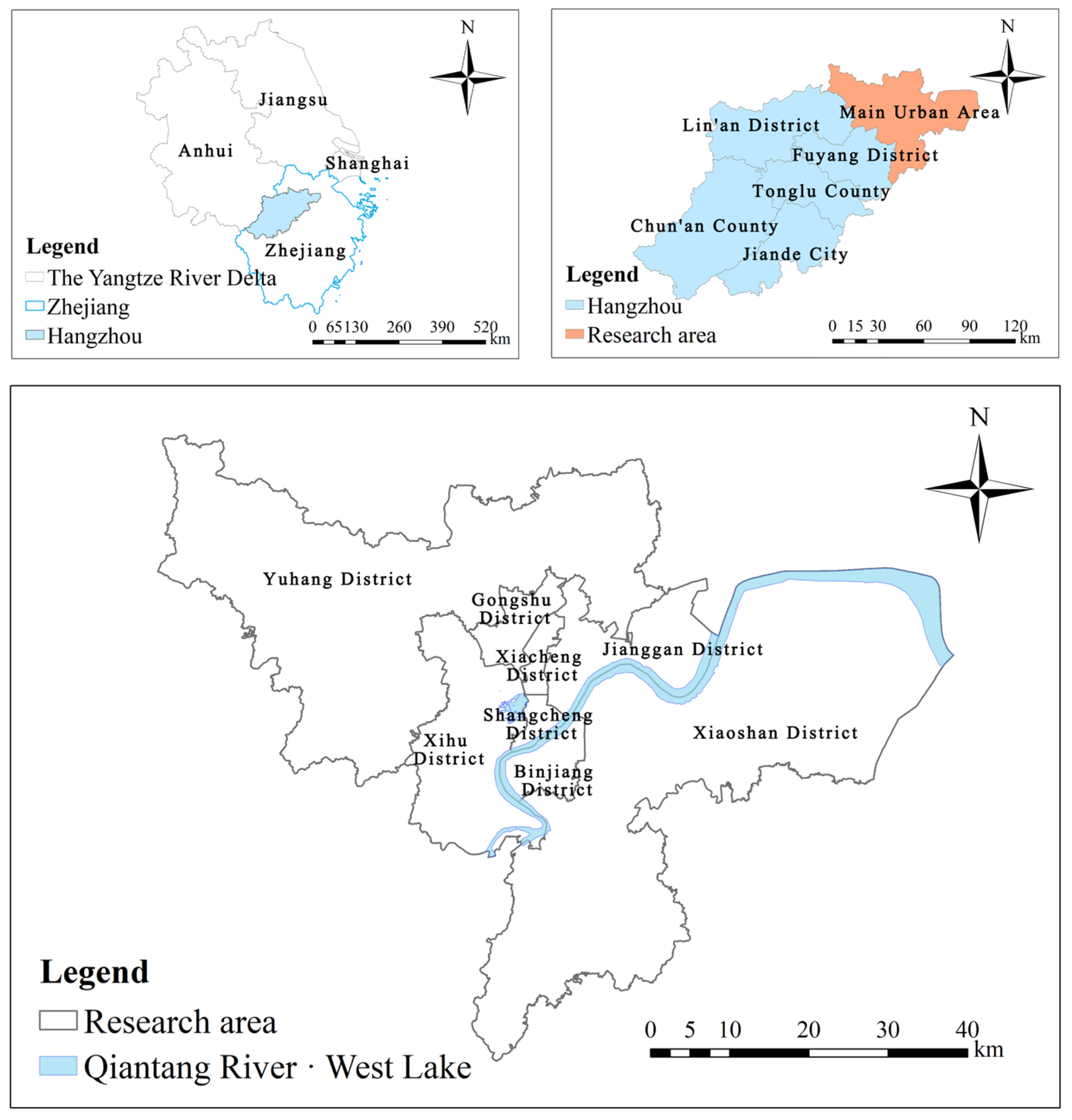
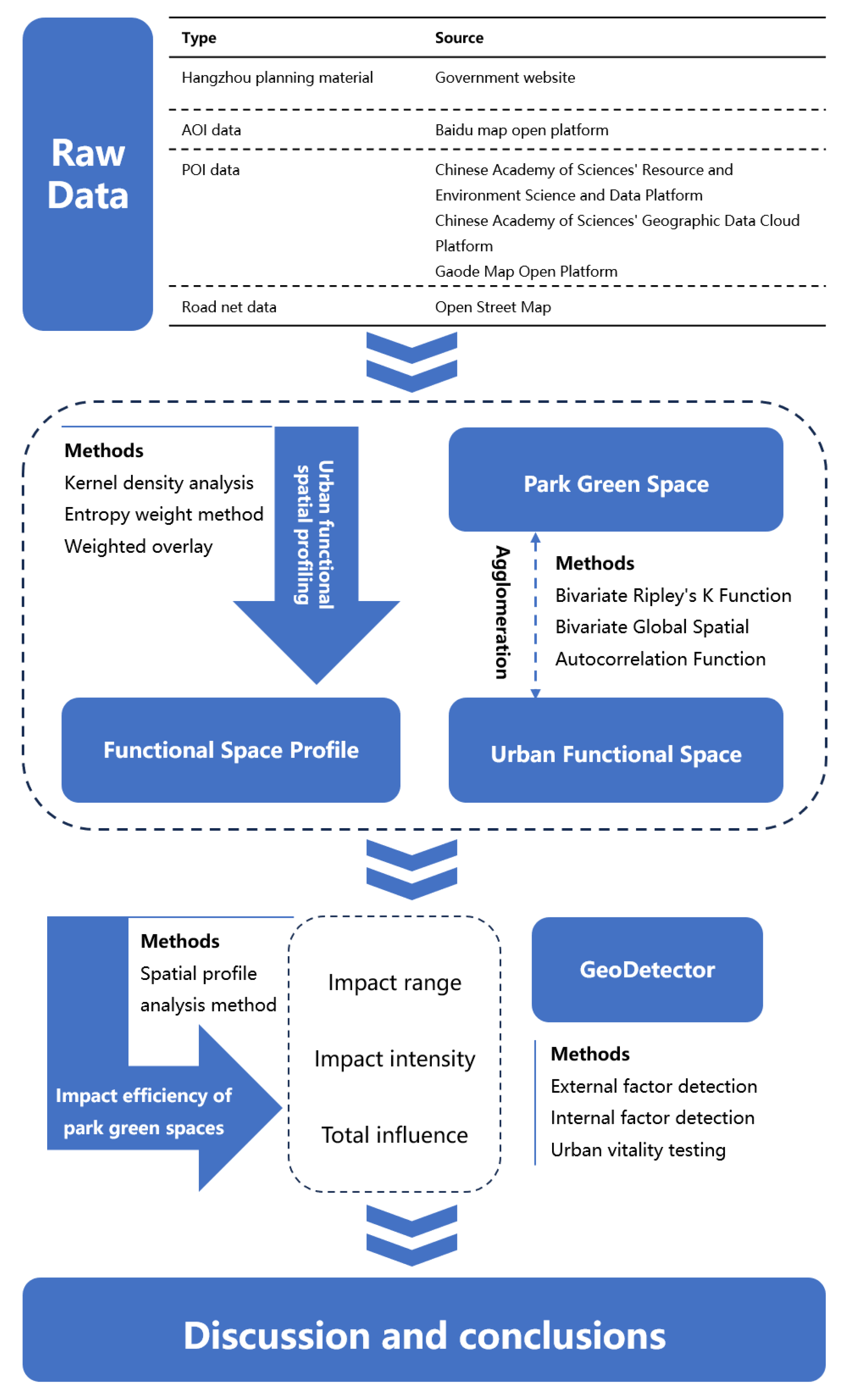
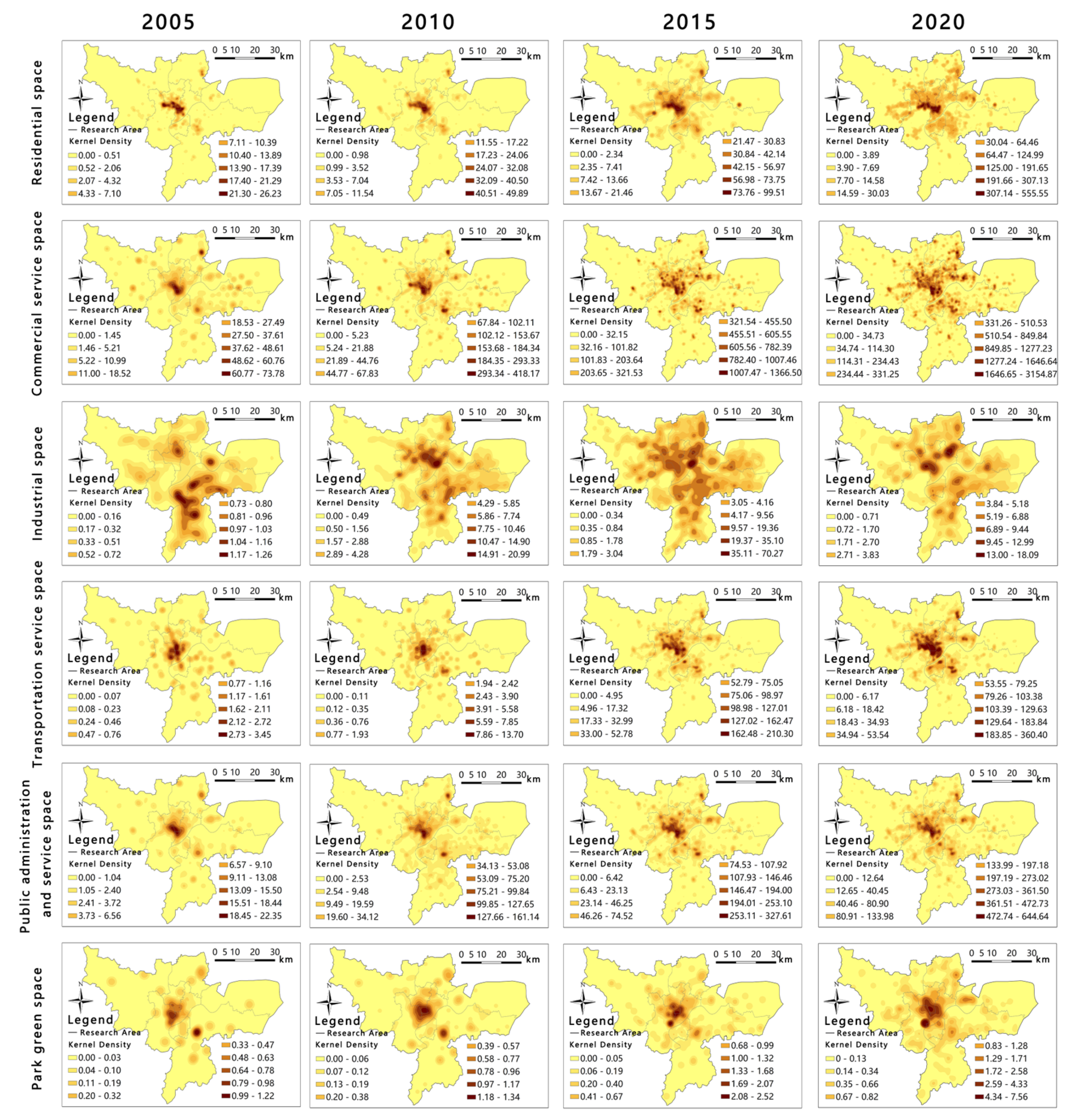

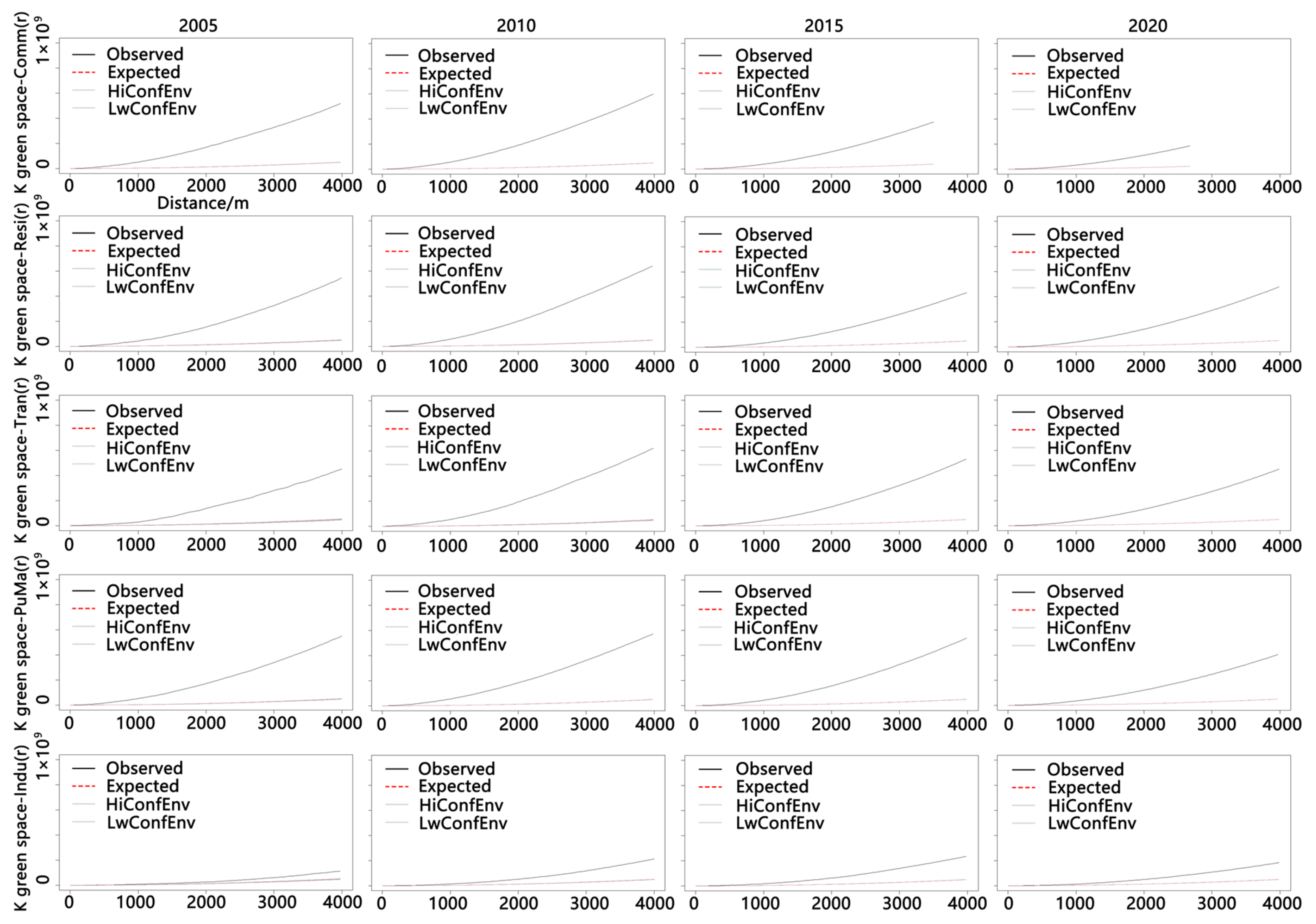
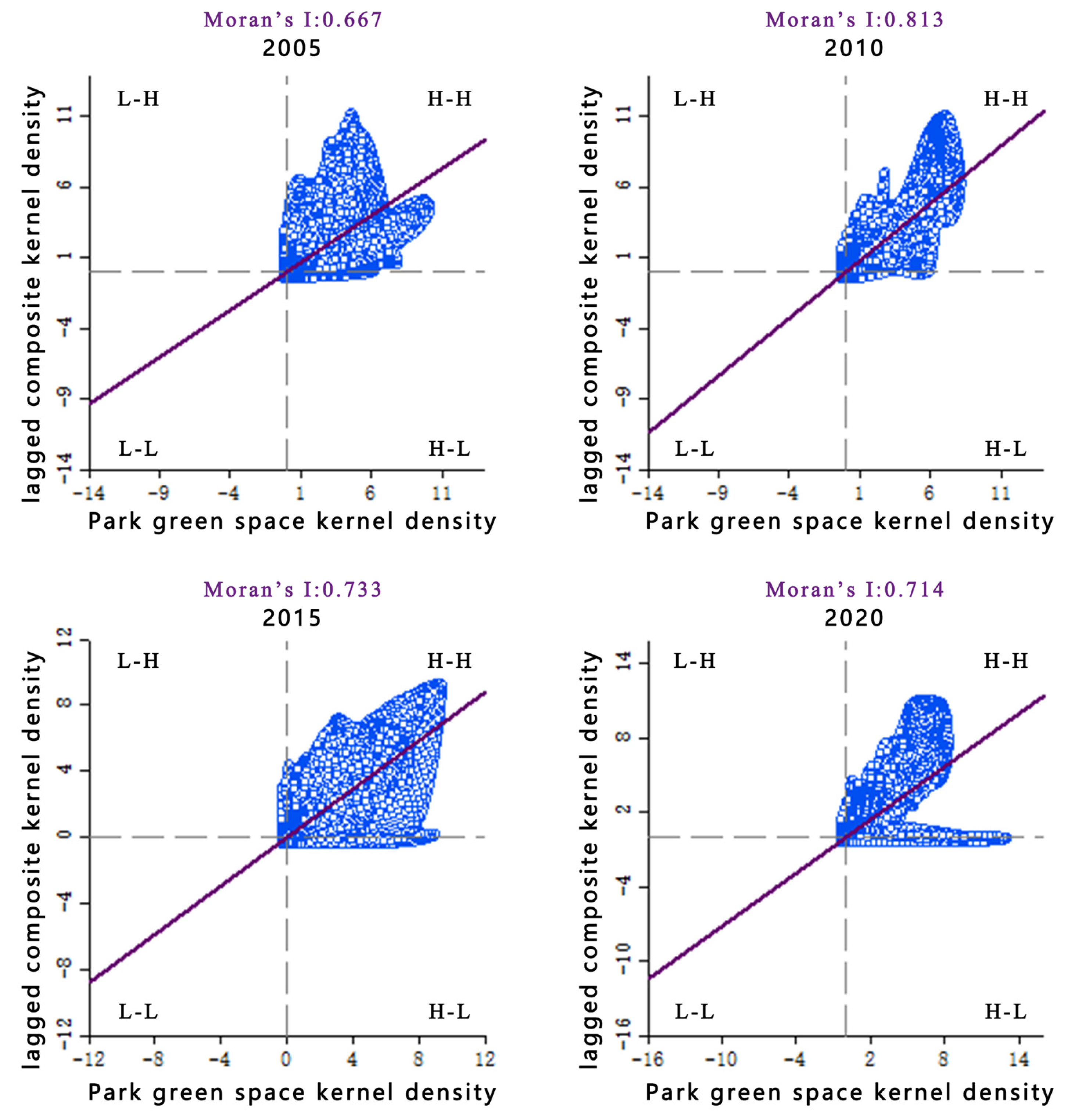
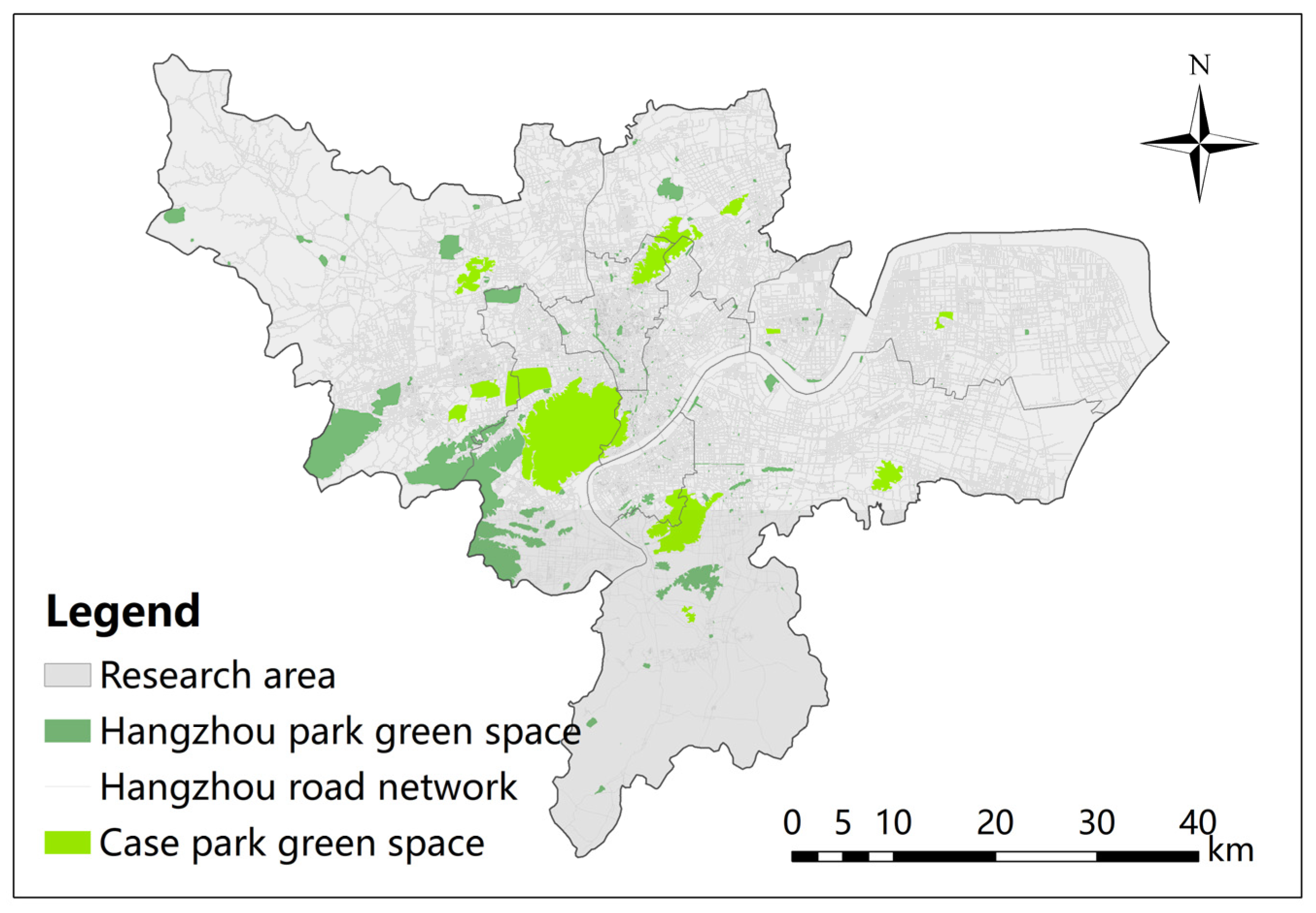
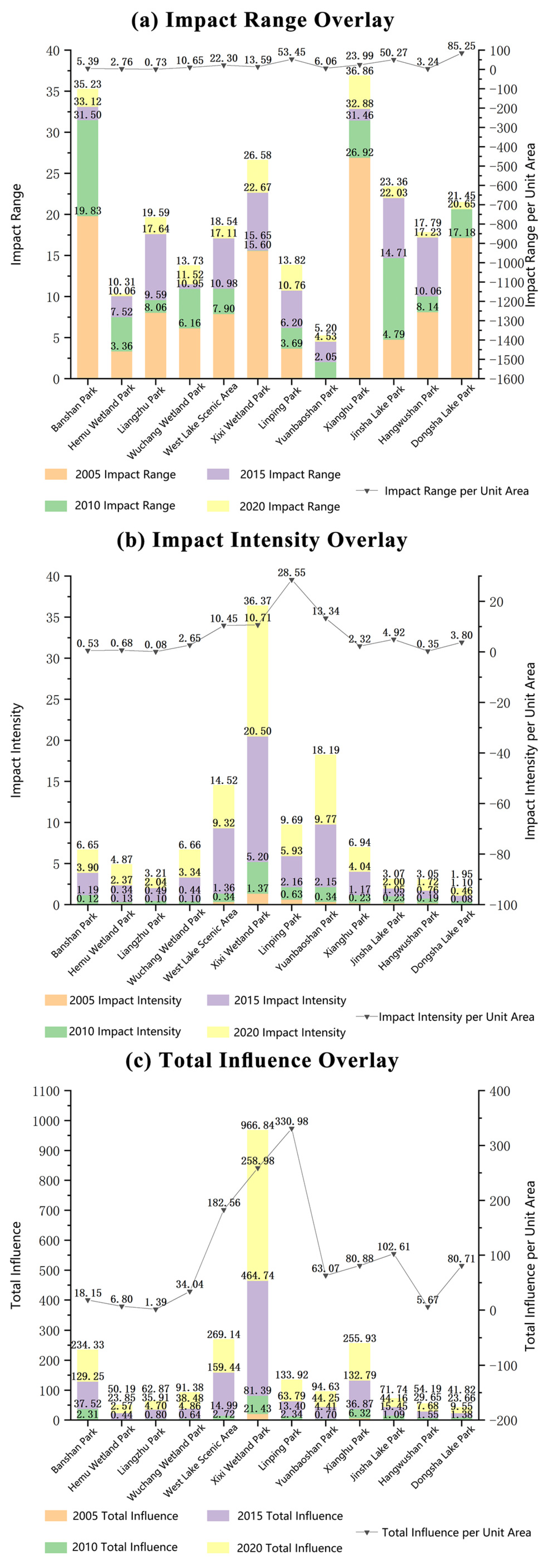

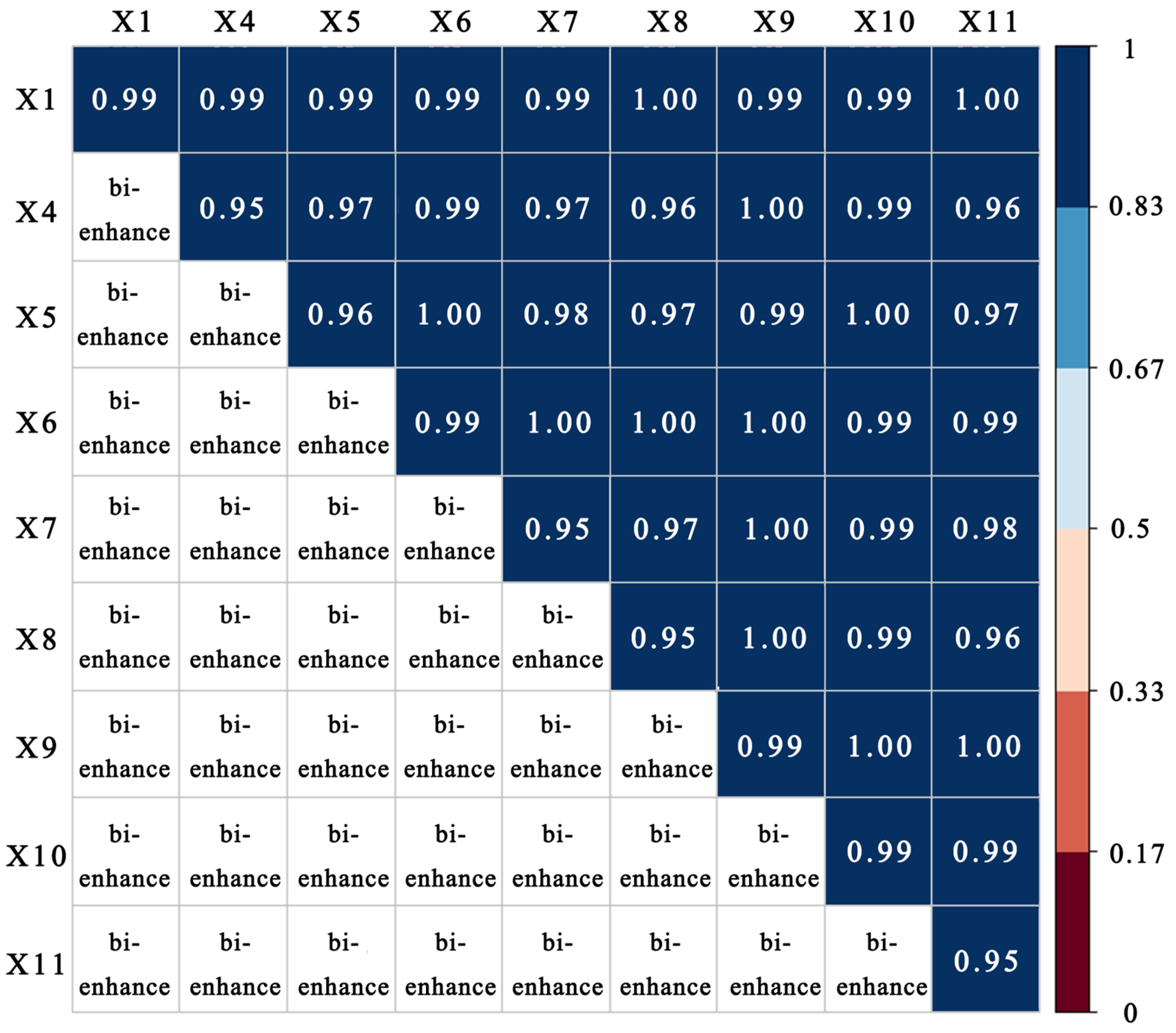
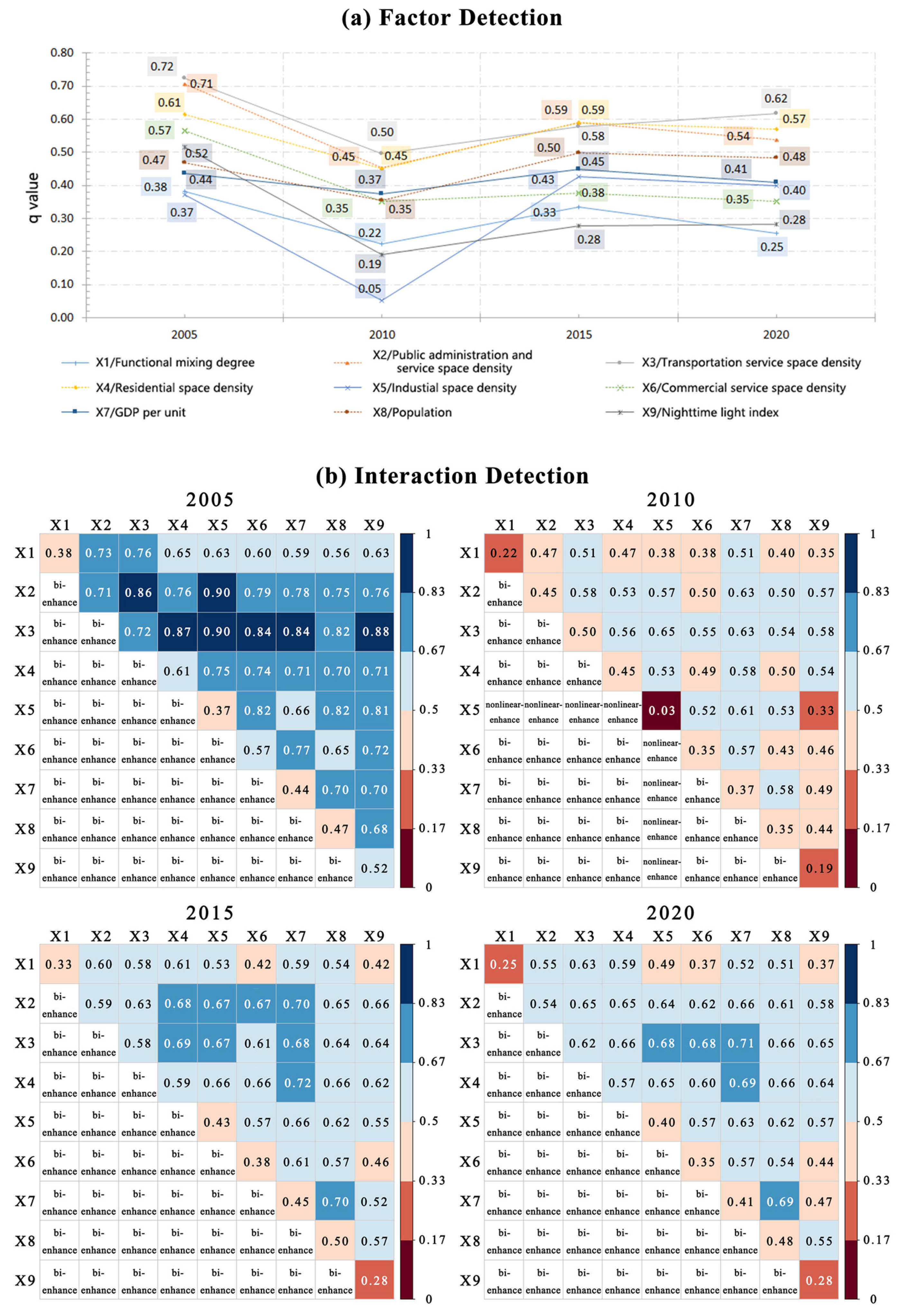
| Classification | Include POI Data Types |
|---|---|
| Residential space | Residential and apartment buildings |
| commercial services space | Catering services, shopping services, financial and insurance services, motorcycle services, car services, car repairs, car sales, accommodation services, and lifestyle services |
| public services and administration space | Administrative office facilities, educational facilities, sports facilities, medical and health facilities, social welfare facilities, scientific research facilities |
| transportation services space | Port terminals, train stations, airports, parking lots, long-distance bus stations |
| industrial production space | Factories, mechanical and electronic companies, construction companies, mining companies, metallurgical and chemical companies, pharmaceutical companies |
| park green spaces | Parks, park squares, city squares, zoos, aquariums, botanical gardens |
| Independent Variable | Area/X1 | Shape/X2 | Boundary Accessibility/X3 | Service Range | Accessibility | Permeability/X12 | Location/X13 | ||||||
|---|---|---|---|---|---|---|---|---|---|---|---|---|---|
| (R = 1500 m)/X4 | (R = 3000 m)/X5 | 15-min Driving/X6 | 30-min Driving/X7 | 15-min Cycling/X8 | 30-min Cycling/X9 | 15-min Walking /X10 | 30-min Walking /X11 | ||||||
| q-value | 0.99 | 0.19 | 0.17 | 0.95 | 0.96 | 0.99 | 0.95 | 0.95 | 0.99 | 0.99 | 0.95 | 0.31 | 0.51 |
| p-value | 0.0 | 0.82 | 0.86 | 0.005 | 0.0 | 0.0 | 0.005 | 0.004 | 0.0 | 0.0 | 0.005 | 0.67 | 0.15 |
Disclaimer/Publisher’s Note: The statements, opinions and data contained in all publications are solely those of the individual author(s) and contributor(s) and not of MDPI and/or the editor(s). MDPI and/or the editor(s) disclaim responsibility for any injury to people or property resulting from any ideas, methods, instructions or products referred to in the content. |
© 2025 by the authors. Licensee MDPI, Basel, Switzerland. This article is an open access article distributed under the terms and conditions of the Creative Commons Attribution (CC BY) license (https://creativecommons.org/licenses/by/4.0/).
Share and Cite
Zhang, S.; Lan, T.; Wu, W. Exploring the Influence and Impact Factors of Park Green Spaces on the Urban Functional Spatial Agglomeration: A Case Study of Hangzhou. Sustainability 2025, 17, 1734. https://doi.org/10.3390/su17041734
Zhang S, Lan T, Wu W. Exploring the Influence and Impact Factors of Park Green Spaces on the Urban Functional Spatial Agglomeration: A Case Study of Hangzhou. Sustainability. 2025; 17(4):1734. https://doi.org/10.3390/su17041734
Chicago/Turabian StyleZhang, Shanfeng, Tianbaiyun Lan, and Wenting Wu. 2025. "Exploring the Influence and Impact Factors of Park Green Spaces on the Urban Functional Spatial Agglomeration: A Case Study of Hangzhou" Sustainability 17, no. 4: 1734. https://doi.org/10.3390/su17041734
APA StyleZhang, S., Lan, T., & Wu, W. (2025). Exploring the Influence and Impact Factors of Park Green Spaces on the Urban Functional Spatial Agglomeration: A Case Study of Hangzhou. Sustainability, 17(4), 1734. https://doi.org/10.3390/su17041734








